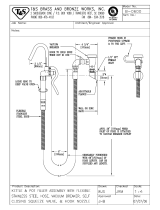
1. Power Cord
2. Push-to-reset Circuit Breaker on Unit
3. Circuit Breaker in House Panel
4. Internal Thermal Switch in Unit
5. Electrical Wall Outlet Plug
6. Switch in the Wall Inlet Stuck O
7. Switch in Wall Inlet Stuck On
8. Remote Control Wire Broken
9. Remote Control Wire - Shorted
10. Flexible Hose Plugged
11 .Tubing in Walls Clogged
12. Dirt Canister Overlled
13. Filter Bag - Clogged (some models)
14. Dirt Canister Lid - O
15. Dirt Canister Gasket Loose
16. Outside Exhaust Blocked
17. Dirt Canister Not Latched
18. Another Wall Inlet Door Open
19. Blower Protection Screen Clogged
20. Relay Stuck - On (On older models)
21. Relay Stuck - O (On older models)
22. Transformer Burned Out (Older models)
23. Loose Wire in Power Unit
24. A Hose Plugged into another Inlet
25. P.C. Board Relay Stuck ON
26. P.C. Board Transformer burned out
27. LED Light
17 www.lindsaymfg.com
3. Circuit Breaker in House Panel - Check your house breaker panel - If the circuit breaker if o,
you may have too many appliances utilizing that circuit. For best results, your power unit
should be on a separate circuit. Try to remove some of the extra circuit load by unplugging
other devices. If the breaker continues to cut o - call your service technician.
4. Internal Thermal Switch in Unit - If your unit comes equipped with an internal thermal
switch and quits running, it may require 10 minutes to cool o before resetting itself.
5. Electrical Wall Outlet Plug - Sometimes the electric wiring from the house breaker panel to
the wall outlet plug can become loose or broken. Plug a lamp or another electric appliance
into the outlet to assure that you are getting power. If not, call your electrical contractor.
6. Switch in the Wall Inlet Stuck in O Position - Plug your exible hose into the other wall
inlets - if your unit functions normally then the problem lies in the switch or remote control
circuit to the inoperative inlet valve. The bolts holding the micro-switch in the inlet valve may
have loosened allowing it to move out of position. Remove the wall inlet face plate and tight-
en the bolts or call your service man.
7. Switch in the Wall Inlet Stuck in On Position - Use your nger to roll the steel ball located in
the top of the neck of the inlet. Some foreign material may have become lodged in the hole
with the ball, preventing it from moving into its proper position. Caution: if this procedure
does not turn your unit o, unplug the power cord and notify your service technician.
8. Remote Control Wire - Broken - Usually, if more than one wall inlet is inoperative, the trouble
is in the remote control wiring, and the wire is either loose or broken, and should be tightened
or replaced.
9. Remote Control Wire - Shorted - Unplug one of the remote control wires that is attached to
the side of the power unit - if the unit stops, it indicates that the remote control wire is shorted
or one of the wall inlet switches is stuck in the on position. If the procedure for number 6 does
not shut the unit o and you cannot locate the short, notify your service man. If the unit does
not stop running when you unplug the remote control wire - either the short is in the power
unit wiring or the relay is stuck. Refer to number 20. Caution: Checking the wiring in the
power unit should only be attempted by a qualied service technician.
10. Flexible Hose - Plugged - If proper airow is not obtained through the hose, remove the
hose from the vacuum inlet, then start the power unit by activating the wall inlet switch. If the
airow, at the inlet, is good, then this will normally indicate a blockage in the hose or wand. If
blockage is in the wand, it can be disassembled and cleaned. If blockage is in the hose, the
hose should rst be laid out straight, then with the hose plugged into the inlet valve and the
power unit running, pick up the hose, starting at the end furthest from the valve and gently
stretch about two feet of it at a time as you proceed along the length of the hose toward the
inlet valve. It this does not clear the stoppage, then remove the hose cus by unscrewing
them, and switch them to the other ends of the hose (these cus have left hand screw threads
so rotate them in a clockwise direction to unscrew from the hose). After this has been done
replace the hose in the inlet valve and with the power unit operating, repeat the process of
stretching the hose. If this fails to unclog the hose, run (handle rst) a screwdriver with at least
a 3/4” diameter handle through the hose.
11. Tubing in Wall - Clogged - Check the airow at the power unit. If the airow is good here
but not at locations further from the power unit, your tubing is either clogged or has broken
open. If you cannot repair this, contact your service man. If you turn the power unit on and
leave the inlet valve furthest from the power unit open and then check the exhaust from the
power unit, you can determine whether you have a break in the tubing or whether the tubing
is clogged. If very little air is coming out of the exhaust of the power unit, then it is probably
an obstruction in the tubing and not a break.
www.lindsaymfg.com 18

























